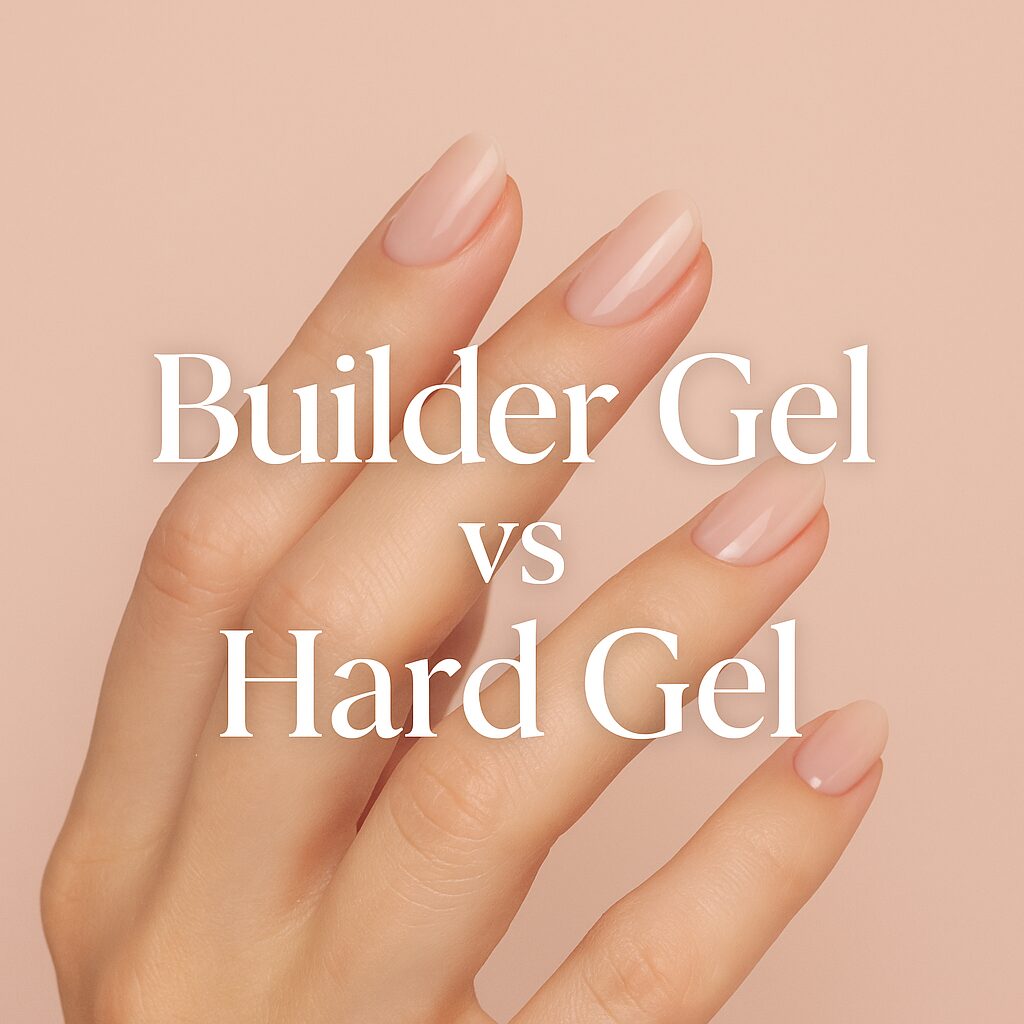
If you’ve ever wandered down the nail-care aisle or scrolled through manicure tutorials, you’ve likely seen both builder gel and hard gel mentioned like twins — but they’re not identical. Each has unique strengths, textures, and removal processes that can completely change how your nails feel and wear.
In this guide, you’ll learn the real differences between builder gel and hard gel, how to use them safely, and which one fits your nail goals best — with insights from trusted beauty resources like L’Oréal Paris and professional gel product makers.
💅 What Is Builder Gel?
Builder gel is a thicker, supportive gel formula used to strengthen or slightly extend your natural nails. It sits between traditional gel polish and hard gel — offering flexibility and strength without feeling overly rigid.
Unlike regular gel polish, builder gel can create structure and shape, building a small “apex” (the natural arch of your nail) to help prevent bending and breaking.
Builder gels are available in two main types:
- Builder in a Bottle (BIAB): Applied like regular polish with a brush, great for easy overlays.
- Pot Builder Gel: Thicker, used with a gel brush for more control and custom shaping.
According to beauty experts at L’Oréal Paris, builder gel is designed to “offer more flexibility and comfort than rigid gels,” making it perfect for those who want a strong, natural-looking overlay. It can also be soaked off with acetone — meaning no need for aggressive filing or e-files.
Best For:
- Strengthening weak or peeling nails
- Short extensions or overlays
- At-home or beginner users
Popular Brands:
- The GelBottle BIAB
- OPI Gel Builder
- Kiara Sky Soak-Off Builder Gel
💡 Pro Tip: Always prep your nails by cleansing and dehydrating the surface before applying builder gel. Oils can cause lifting, even with the best formulas.
What Is Hard Gel?
Hard gel, on the other hand, is the heavy-duty version of gel enhancement — it’s ultra-durable, sculptable, and ideal for building long, strong nails that hold their shape.
Unlike builder gel, hard gel is non-porous, meaning it can’t be soaked off with acetone. It must be filed down or removed by a professional.
Hard gels have a thicker texture and need more precision to apply, but once cured under a UV or LED lamp, the result is a glass-like, high-shine finish that resists chips and cracks.
As explained by L’Oréal’s nail experts, hard gel “mimics acrylic in strength” and is best for sculpted extensions or clients who use their hands a lot.
Best For:
- Long nail extensions or advanced designs
- People who want salon-level durability
- Professional nail technicians
Popular Brands:
- IBD Hard Gel
- Gelish Hard Builder
- Light Elegance Builder
💡 Quick Note: Hard gel sets incredibly strong but requires careful removal. Over-filing can weaken your natural nails, so always let a trained tech handle it.
⚖️ Builder Gel vs Hard Gel — The Main Differences
Here’s how they stack up side by side:
| Feature | Builder Gel | Hard Gel |
|---|---|---|
| Removal | Soak-off with acetone | File-off only |
| Texture | Thinner, self-leveling | Thicker, sculptable |
| Flexibility | Softer and more flexible | Rigid and dense |
| Ideal Use | Overlays, short nails | Extensions, long nails |
| Durability | 2–3 weeks | 3–4 weeks |
| Skill Level | Beginner-friendly | Professional use |
| Look | Natural, soft-gloss | Glassy, high-shine |
| Maintenance | Easier to remove or refill | Requires filing and refills |
Both formulas can give you long-lasting results — the difference lies in your lifestyle, maintenance routine, and desired finish.
⏱️ Which One Lasts Longer?
Durability-wise, hard gel has the upper hand. Its denser structure helps it resist bending, cracking, and breaking — making it ideal for people who use their hands often or prefer long nails.
Hard gel can last up to four weeks, while builder gel usually lasts about two to three weeks before you’ll need a refill or touch-up.
However, builder gel has a different kind of longevity — because it’s easier to maintain and soak off, you can keep your nails looking fresh without causing damage over time.
💬 Expert Insight: Manufacturers like Zurno note that while hard gels deliver maximum wear, softer builder gels are a better match for clients who prefer flexible, natural nails and frequent style changes.
🧴 Which One Is Easier to Remove?
This is where builder gel clearly wins.
- Builder Gel: Can be soaked off with acetone in 10–15 minutes (similar to gel polish).
- Hard Gel: Must be filed off because it doesn’t break down in acetone.
Builder gels are more user-friendly for at-home use. Hard gels, while stronger, need careful filing — ideally with a professional e-file to avoid thinning your natural nails.
⚠️ Tip: If you plan to wear gels regularly, avoid peeling or prying them off — it removes protective nail layers and causes brittleness. Always soak or file gently.
🌿 Which One Is Healthier for Natural Nails?
Both can be completely safe when applied and removed properly. The key isn’t the gel — it’s the technique.
Builder gel offers a softer, more forgiving layer that bends slightly with your natural nail, helping prevent cracks or stress breaks. It’s an excellent option for those with thin, brittle, or peeling nails.
Hard gel gives unmatched strength but requires extra care during removal to protect your natural nail underneath.
In short:
- Choose builder gel for flexibility and comfort.
- Choose hard gel for durability and structure.
🔁 Can You Infill or Reuse Them?
Absolutely — both gels can be infilled instead of removed completely each time.
Builder Gel: Lightly file off the top layer and apply fresh gel to the regrown area. This prevents thinning from repeated soak-offs.
Hard Gel: Commonly infilled by professionals. The top surface is filed down, then reshaped and re-balanced.
Regular maintenance every 2–3 weeks helps avoid lifting, cracks, and gaps at the cuticle.
💗 Builder Gel vs Hard Gel — Pros and Cons
Builder Gel
Pros:
✅ Easy to soak off
✅ Gentler on natural nails
✅ Beginner-friendly
✅ Feels light and flexible
Cons:
❌ Slightly less durable
❌ May lift if applied too thick
❌ Needs more frequent refills
Hard Gel
Pros:
✅ Extremely strong and long-lasting
✅ Perfect for sculpting long nails
✅ High-gloss, professional finish
Cons:
❌ Must be filed off
❌ Requires more skill
❌ Can cause damage if over-filed
💅 Which One Should You Choose?
The best choice depends on your nail goals and maintenance habits.
Choose Builder Gel if you:
- Love natural-looking nails
- Prefer to do your nails at home
- Want a soak-off option
- Have thin or sensitive nails
Choose Hard Gel if you:
- Want ultra-strong, long extensions
- Don’t mind professional removal
- Need nails that last 3–4 weeks
- Prefer a glossy, sculpted finish
💬 As beauty experts from L’Oréal Paris note, builder gels are ideal for beginners and natural nail lovers, while hard gels are better suited for advanced users or salon regulars who want long-lasting, sculpted results.
🧠 Expert Tips for Longer-Lasting Gel Nails
- Prep properly. Always clean, buff, and dehydrate your nails before applying gel.
- Apply thin layers. Thick coats lead to uneven curing and lifting.
- Cap the tips. Seal the edge of your nail with each layer for longer wear.
- Cure completely. Use an LED/UV lamp and follow the product’s cure time exactly.
- Avoid hot water for 2–3 hours after application.
- Use cuticle oil daily. Hydration keeps nails flexible and strong.
- Protect your nails. Wear gloves when cleaning or doing dishes.
For even more longevity tricks, check out our guide:
👉 How to Make Nail Polish Last Longer — 10 Expert-Approved Tips for a Chip-Free Manicure
🙋♀️ FAQs
Q: Can I use builder gel instead of hard gel for extensions?
A: Yes — builder gel can create short extensions, but for longer or sculpted nails, hard gel gives more support.
Q: Which one damages nails less?
A: Builder gel is gentler since it’s soak-off, but both are safe when applied and removed properly.
Q: Can I combine builder gel and hard gel in one set?
A: It’s not recommended — they have different chemistry and removal methods, which can cause lifting.
Q: Can I apply builder gel or hard gel over natural nails?
A: Yes, both can be applied directly over natural nails. Builder gel works best as a strengthening overlay, while hard gel is usually reserved for adding length or sculpting. If you just want durability and shine, builder gel is the better choice.
Does builder gel need a base coat?
A: Most builder gels can be used without a separate base coat — especially builder-in-a-bottle (BIAB) formulas, which act as both base and builder. However, some traditional pot gels may still require a base layer for better adhesion.
Is builder gel safer than acrylic?
A: Builder gel is generally gentler and more flexible than acrylic. It bonds smoothly to the nail and doesn’t require harsh primers or heavy filing. However, acrylic may still be preferred for extreme length or heavy-duty durability.
Can builder gel break or crack easily?
A: Not if applied correctly in thin, even layers and fully cured under LED or UV light. Cracking usually happens from improper curing, thick application, or exposure to hot water too soon after application.
Can I mix hard gel and builder gel in one set?
A: It’s best not to. The two have different removal methods and curing behaviors. Mixing them can cause lifting or uneven curing.
Which one is more cost-effective — builder gel or hard gel?
A: Builder gel is typically more affordable and lasts for multiple at-home manicures. Hard gel often requires professional tools and removal, which can make it a bit pricier long-term.
